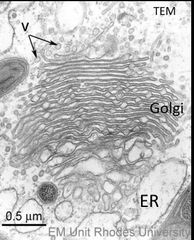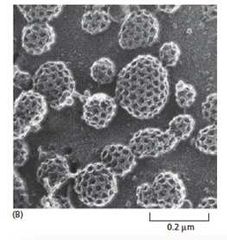![]()
![]()
![]()
Use LEFT and RIGHT arrow keys to navigate between flashcards;
Use UP and DOWN arrow keys to flip the card;
H to show hint;
A reads text to speech;
33 Cards in this Set
- Front
- Back
|
What is the secretory pathway? List the steps. |
The pathway protein travels on beginning with the ER. It is how proteins get to the correct destination.
1. ER <---> Golgi apparatus <---> Endosome ---> lysosome 2. ER ---> Golgi apparatus---> Plasma membrane ---> Extracellular space via exocytosis |
|
|
Do all proteins on the secretory pathway go to the end of the line? |
No. They stop in the appropriate organelle/destination |
|
|
What is exocytosis? |
A process by which the contents of a cell transport vesicle are released to the exterior through fusion of the vesicle membrane with the plasma membrane. |
|
|
What is endocytosis? |
The process by which cells take in materials through an invagination of the plasma membrane, which surrounds the ingested material in a membrane enclosed vesicle. Cell surface ---> Endocytic vesicle ---> Endosome ---> Lysosome (or material is recycled). |
|
|
What is the Cis Golgi? The trans Golgi? |
The entrance, which is adjacent to the ER and the exit, which points toward the plasma membrane. Respectively. |
|
|
What is anterograde transport? Retrograde transport? |
Protein movement from the ER to the cis Golgi Protein movement from the Golgi to the ER |
|

What is this an image of? |
It is a TEM of the Golgi Apparatus connected via its cis end to the ER. |
|
|
What are vesicle coat proteins, and what are some examples? |
Coat proteins assemble on newly budding vesicles, leading to the collection of the vesicle cargo and membrane bending to form the vesicle. Examples include: Clathrin, COP1, COP2, and EVCP (exocytic vesicle coat protein). |
|
|
What are the steps to vesicle formation? |
1. A GTP-Binding protein (GBP) associated with GDP binds to a site on the membrane.
2. GTP is substituted for GDP in the GTP-binding protein. This binds the coat proteins that form the membrane into a vesicle.
3. Coat proteins contain specific receptors that bind aa sequences present only in proteins bound for the target destination. - These coat proteins include membrane cargo protein, "cargo-receptor protein," and vSNARE proteins. |
|
|
What are cargo-receptor proteins? |
They bind soluble cargo proteins in the forming vesicle. |
|
|
What are v-SNARE proteins? |
Snares on vesicles that interact with complementary snares on the vesicle target membrane (t-SNARES), firmly docking the vesicle in place. |
|
|
What are exocytic vesicles? |
Vesicles that are targeted to the plasma membrane. |
|
|
What are endocytic vesicles? What is their coat protein? |
Vesicles formed by invagination of the plasma membrane. Targeted to early endosomes so cargo can go through further sorting. Clathrin and adaptin 2 |
|
|
Where do transport vesicles with clathrin and adaptin 1 coats go? |
From the Golgi to late endosomes. |
|
|
Where do COP1 coated vesicles go? COP2? |
Golgi to ER (retrograde): For mis-sorted ER or Golgi proteins. Also for ER proteins returned after glycosylation. Such proteins contain an ER return sequence.
ER to Golgi (anterograde) |
|
|
What are the steps for vesicle scission? |
1. Cargo receptors pick up cargo molecules from the lumen. These receptors have an end that is exposed to the cytosol.
2. Adaptins (which are bound to the coat proteins on the cytosolic side) capture the cargo receptors, creating the protein coat.
3. Dynamin proteins (specific to Clathrin vesicles) encircle the neck of the budding vesicle and pinch it off.
4. The vesicle sheds its coat and continues on its way.
Uses GTP hydrolysis for energy. |
|

What is this a picture of? |
A TEM of a budding Clathrin vesicle. |
|

What is this a picture of? |
An SEM of a Clathrin-coated vesicle. |
|
|
What are the steps for vesicle docking? |
Docking depends on tethers, snares, and a diverse family of monomeric GTPases called Rab proteins. 1. Tethers on the target membrane recognize the specific Rab protein on the vesicle. 2. Once the Rab protein is tethered, the v-SNARE attaches to the target membrane's t-SNARE, docking the vesicle in place. 3. The vesicle fuses with the target membrane, releasing its cargo and adding its membrane to the target organelle's. |
|
|
What is the constitutive exocytosis pathway? |
The pathway that supplies the plasma membrane with newly made lipids and proteins, enabling it to expand prior to cell division and refresh old lipids and proteins in non-proliferating cells. Unregulated. |
|
|
What is secretion? |
A process that uses the constitutive exocytosis pathway to release soluble proteins outside of the cell. |
|
|
What is the regulated exocytosis pathway? |
It operates only in cells specialized for secretion. Such cells produce large quantities of a particular product (eg. Hormones, mucus, digestive enzymes, etc). These vesicles are stored for later and only secreted once an extracellular signal tells the cell to do so. |
|
|
What are the two methods for visualizing the secretory pathway? |
1. Viral protein (VSVG) linked to fluorescent reporter protein (GFP). VSVG-GFP expressed from virus in cultured cells yields green fluorescence. VSVG is a conditional mutant retained in the ER at 40⁰C, but released to Golgi and eventually PM when at 32⁰C.
2. Involves mixing pure radioactively labeled protein + signal sequence with isolated organelle. |
|
|
What is the UPR, and why is it important? |
It is the unfolded protein response in the ER. It's a complex molecular program triggered by the accumulation of misfolded proteins in the ER. Allows cells to expand and produce the machinery needed to restore proper folding. Also slows the production of new proteins until issue is solved.
Essentially, it's quality control to ensure misfolded proteins aren't transported. |
|
|
The ER and Golgi Apparatus are sites for glycosylation. What are some examples? |
1. ER: attachment of core N-linked oligosaccharides (asparagine) 2. Cis-Golgi: Attachment of core O-linked oligosaccharides (serine and threonine) 3. Medial-Golgi: Addition of galactose to oligosaccharide chains. 4. Trans-Golgi Network: Removal of terminal monosaccharides |
|
|
What does the specific stepwise modification of oligosaccharides result in? |
1. Proper folding in ER 2. Protein stability in ER 3. Protein stability in Golgi 4. Function of many transmembrane proteins 5. A signal in proteins that are to be delivered from the trans-golgi network to early endosomes. |
|
|
What are some of the signals that target vesicles to the endosome branches of the exocytosis pathway? |
AP3, which targets trans-golgi network proteins with specific sequence to the lysosome.
Mannose-6-phosphate (a carbohydrate), targets specific trans-golgi network proteins to AP1 vesicles destined for the early endosome via an M6P receptor. M6P not revealed until trans-Golgi network. |
|
|
What is autophagy? |
A defense against damaged organelles.
An additional pathway that supplies materials to lysosomes. Used to degrade obsolete parts of the cell. Increased when eukaryotic cells are starved or when they remodel themselves extensively during development. Essentially, the cell eats itself and leftover aa's can be recycled. |
|
|
What is the early endosome? |
It's formed by the fusion of endocytic vesicles from the plasma membrane and trans-Golgi network secretory vesicles. It sorts materials arriving via endocytosis. A slightly lowered pH causes plasma membrane receptors to release cargo. |
|
|
What is the late endosome? |
Formed by maturation of early endosome and more vesicles from the trans-Golgi network. It specifically activates proteases in a lowering pH environment, eventually causing the lysosome to activate its digestive enzymes. |
|
|
What are the two forms of endocytosis? |
Pinocytosis: "Cellular drinking." Involves the ingestion of fluid and small molecules via small pinocytic vesicles.
Phagocytosis: "Cellular eating." Involves the ingestion of large particles such as microorganisms and other debris via large vesicles called phagosomes. A defense against pathogens and dead cells. (Macrophages and neutrophils do this to defend the cell) |
|
|
What is an example of the unfolded protein response (UPR) mechanism failing? |
Adult onset diabetes. Tissues eventually become resistant to the effects of insulin. To compensate, the pancreas increases insulin production. Eventually, the ER in cells reaches capacity and UPR can trigger cell death |
|
|
What is familial hypercholesterolemia an example of? |
Lack of the LDL receptor gene, which prevents LDL from being transported from outside the cell to endosomes which turn into lysosomes and digest the LDL. Essentially, the body can't remove bad cholesterol from the blood. |

